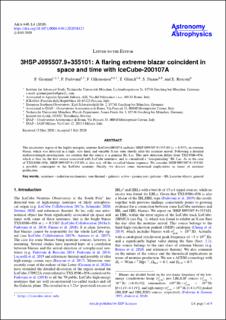3HSP J095507.9+355101: A flaring extreme blazar coincident in space and time with IceCube-200107A
| dc.contributor.author | Giommi, P. | |
| dc.contributor.author | Padovani, P. | |
| dc.contributor.author | Oikonomou, Foteini | |
| dc.contributor.author | Glauch, T. | |
| dc.contributor.author | Paiano, S. | |
| dc.contributor.author | Resconi, E. | |
| dc.date.accessioned | 2021-09-09T08:15:13Z | |
| dc.date.available | 2021-09-09T08:15:13Z | |
| dc.date.created | 2021-01-04T16:55:52Z | |
| dc.date.issued | 2020 | |
| dc.identifier.citation | Astronomy and Astrophysics (A & A). 2020, 640 . | en_US |
| dc.identifier.issn | 0004-6361 | |
| dc.identifier.uri | https://hdl.handle.net/11250/2774834 | |
| dc.description.abstract | The uncertainty region of the highly energetic neutrino IceCube200107A includes 3HSP J095507.9+355101 (z = 0.557), an extreme blazar, which was detected in a high, very hard, and variable X-ray state shortly after the neutrino arrival. Following a detailed multiwavelength investigation, we confirm that the source is a genuine BL Lac. This new detection differs from TXS 0506+056, which is thus far the first source associated with IceCube neutrinos, and is considered a “masquerading” BL Lac. As in the case of TXS 0506+056, 3HSP J095507.9+355101 is also way off the so-called blazar sequence. We consider 3HSP J095507.9+355101 a possible counterpart to the IceCube neutrino. Finally, we discuss some theoretical implications in terms of neutrino production. | en_US |
| dc.language.iso | eng | en_US |
| dc.publisher | EDP Sciences | en_US |
| dc.title | 3HSP J095507.9+355101: A flaring extreme blazar coincident in space and time with IceCube-200107A | en_US |
| dc.type | Peer reviewed | en_US |
| dc.type | Journal article | en_US |
| dc.description.version | publishedVersion | en_US |
| dc.source.pagenumber | 0 | en_US |
| dc.source.volume | 640 | en_US |
| dc.source.journal | Astronomy and Astrophysics (A & A) | en_US |
| dc.identifier.doi | 10.1051/0004-6361/202038423 | |
| dc.identifier.cristin | 1865131 | |
| cristin.ispublished | true | |
| cristin.fulltext | original | |
| cristin.qualitycode | 2 |
Tilhørende fil(er)
Denne innførselen finnes i følgende samling(er)
-
Institutt for fysikk [2708]
-
Publikasjoner fra CRIStin - NTNU [38672]
